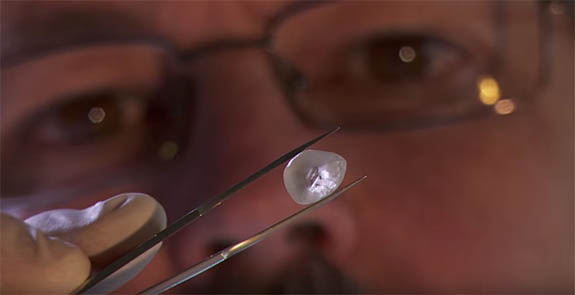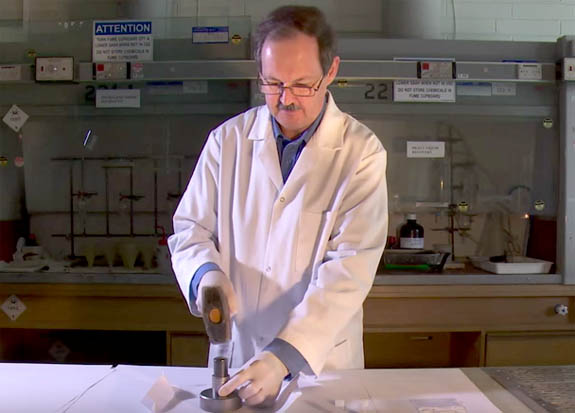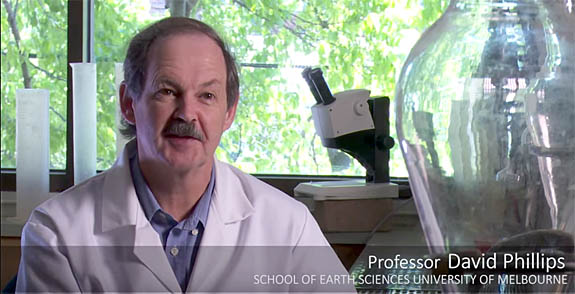November 18th, 2015
Step into the lab of Professor David Phillips of the University of Melbourne and you might find him armed with a mallet, bashing an 8-carat rough diamond into a material that looks like beach sand. By pulverizing a diamond and analyzing its inclusions, Phillips believes he can root out the diamond's original source — the mother lode.

Phillips, who is a geologist and head of the School of Earth Sciences at the University of Melbourne, requires research specimens that have small imperfections. The 8-carat gem destroyed in the images below, for instance, had two tiny green inclusions, which were actually a green mineral called clinopyroxene.

The only way to get to the inclusions is to turn the diamond into dust. This is accomplished with a heavy duty plunger/battering device. The diamond is put in the receptacle. A plunger is placed over the diamond and then the professor takes a heavy mallet and gives it a good smack. Diamonds are the hardest material known to man, but they do fracture under this type of force.

The mineral clinopyroxene contains small amounts of radioactive potassium, which can be dated. Phillips is not trying to reveal when the diamond was formed, but, more importantly, when it was propelled 100 miles to the surface via a volcanic eruption. This is when the diamond picked up its trace elements.

Over time, diamonds from a single eruption may spread vast distances by way of erosion, glaciers or even continental drift.
But, armed with the age of the volcanic eruption, Phillips can match the diamond to known geological events. “It’s like looking for a unique word in War and Peace," he said, "and instead of having to search the whole book, you only have to look through a handful of pages.”
According to the University of Melbourne's website, Phillips and his colleagues previously dated clinopyroxene inclusions in diamonds found on the Namibian coast and showed that they likely originated from the erosion of volcanoes more than 400 miles inland. It's likely the diamonds slowly migrated to the coast by river.
Impressed by this ground-breaking research, diamond exploration companies, such as Namakwa Diamonds, have donated sizable diamonds to be sacrificed in Phillips' lab in the name of science. The value of the 8-carat rough diamond in the video is about $4,500, a very modest sum compared to the enormous benefits associated with pinpointing a mother lode.
Professor Phillips' research may help diamond exploration along the west coast of southern Africa and in the Wolmaransstad area of North West Province, South Africa — two areas with rich deposits of diamonds, but where the source is still unknown.
Check out the video of Professor Phillips taking a mallet to the 8-carat diamond rough.
Source: University of Melbourne.

Phillips, who is a geologist and head of the School of Earth Sciences at the University of Melbourne, requires research specimens that have small imperfections. The 8-carat gem destroyed in the images below, for instance, had two tiny green inclusions, which were actually a green mineral called clinopyroxene.

The only way to get to the inclusions is to turn the diamond into dust. This is accomplished with a heavy duty plunger/battering device. The diamond is put in the receptacle. A plunger is placed over the diamond and then the professor takes a heavy mallet and gives it a good smack. Diamonds are the hardest material known to man, but they do fracture under this type of force.

The mineral clinopyroxene contains small amounts of radioactive potassium, which can be dated. Phillips is not trying to reveal when the diamond was formed, but, more importantly, when it was propelled 100 miles to the surface via a volcanic eruption. This is when the diamond picked up its trace elements.

Over time, diamonds from a single eruption may spread vast distances by way of erosion, glaciers or even continental drift.
But, armed with the age of the volcanic eruption, Phillips can match the diamond to known geological events. “It’s like looking for a unique word in War and Peace," he said, "and instead of having to search the whole book, you only have to look through a handful of pages.”
According to the University of Melbourne's website, Phillips and his colleagues previously dated clinopyroxene inclusions in diamonds found on the Namibian coast and showed that they likely originated from the erosion of volcanoes more than 400 miles inland. It's likely the diamonds slowly migrated to the coast by river.
Impressed by this ground-breaking research, diamond exploration companies, such as Namakwa Diamonds, have donated sizable diamonds to be sacrificed in Phillips' lab in the name of science. The value of the 8-carat rough diamond in the video is about $4,500, a very modest sum compared to the enormous benefits associated with pinpointing a mother lode.
Professor Phillips' research may help diamond exploration along the west coast of southern Africa and in the Wolmaransstad area of North West Province, South Africa — two areas with rich deposits of diamonds, but where the source is still unknown.
Check out the video of Professor Phillips taking a mallet to the 8-carat diamond rough.
Source: University of Melbourne.



